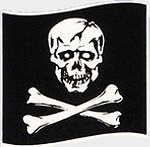Hobby Master HA0307 USN Grumman F6F-5 Hellcat Fighter - "White 50," VF-17 "Jolly Rogers", USS Hornet (CV-12), 1945 (1:32 Scale)
"All available fighter pilots! Man your planes!"
- Message barked into the squawk box of the Essex' ready room when the ship's radar had detected three large groups of incoming Japanese planes during the Battle of Leyte Gulf, October 24th, 1944
 The F6F embodied the early lessons learned by users of Grumman's previous fleet-defense fighter, the Wildcat. In June 1941, Grumman lowered the wing center section to enable the undercarriage to be wider splayed, fitting more armor-plating around the cockpit to protect the pilot while also increasing the fighter's ammunition capacity. When the prototype made its first flight, it was realized that a more powerful engine was needed to give the fighter a combat edge. A Pratt & Whitney R-2800-10 engine was installed for added power.
The F6F embodied the early lessons learned by users of Grumman's previous fleet-defense fighter, the Wildcat. In June 1941, Grumman lowered the wing center section to enable the undercarriage to be wider splayed, fitting more armor-plating around the cockpit to protect the pilot while also increasing the fighter's ammunition capacity. When the prototype made its first flight, it was realized that a more powerful engine was needed to give the fighter a combat edge. A Pratt & Whitney R-2800-10 engine was installed for added power.
The aircraft made its combat debut in August 1943, and from that point on, the question of aerial supremacy in the Pacific was never in doubt. Hellcats served aboard most of the US Navy's fleet carriers, being credited with the destruction of 4,947 aircraft up to V-J Day. The Fleet Air Arm was also a great believer in the Hellcat, procuring almost 1,200 planes between 1943-45. The Hellcat saw only limited service in the post-war years, being replaced by the more powerful F9F Bearcat. Of the nine F6Fs believed to be airworthy today, seven are based in the USA and two are located in the UK.
This particular 1:32 scale Grumman F6F-5 Hellcat fighter was attached to VF-17 "Jolly Rogers", then embarked upon the USS Hornet (CV-12) during 1945.
Sold Out!
Dimensions:
Wingspan: 16-3/4-inches
Length: 12-1/4-inches
Release Date: June 2019
 Historical Account: "Jolly Rogers" - Three distinct U.S. Naval Aviation squadrons have used the name and insignia of the Jolly Roger: VF-61 (originally VF-17), VF-84, and VFA-103. While these are distinctly different squadrons that have no lineal linkage, they all share the same Jolly Roger name, the skull and crossbones insignia and traditions.
Historical Account: "Jolly Rogers" - Three distinct U.S. Naval Aviation squadrons have used the name and insignia of the Jolly Roger: VF-61 (originally VF-17), VF-84, and VFA-103. While these are distinctly different squadrons that have no lineal linkage, they all share the same Jolly Roger name, the skull and crossbones insignia and traditions.
The first incarnation of the Jolly Rogers was established on January 1st, 1943 at NAS Norfolk, as VF-17, flying the F4U Corsair. Inspired by the piratical theme of the aircraft's name, VF-17's commanding officer Tommy Blackburn selected the Jolly Roger as the squadron's insignia. VF-17 was redesignated as VF-5B in 1946, and as VF-61 in 1948. While in existence, VF-61 flew the F6F-5 Hellcat, F4U-1 Corsair, F8F-2 Bearcat, F9F-2/4 Panther, F9F-8 Cougar, and F3H-2M Demon, and was disestablished on April 15th, 1959.


